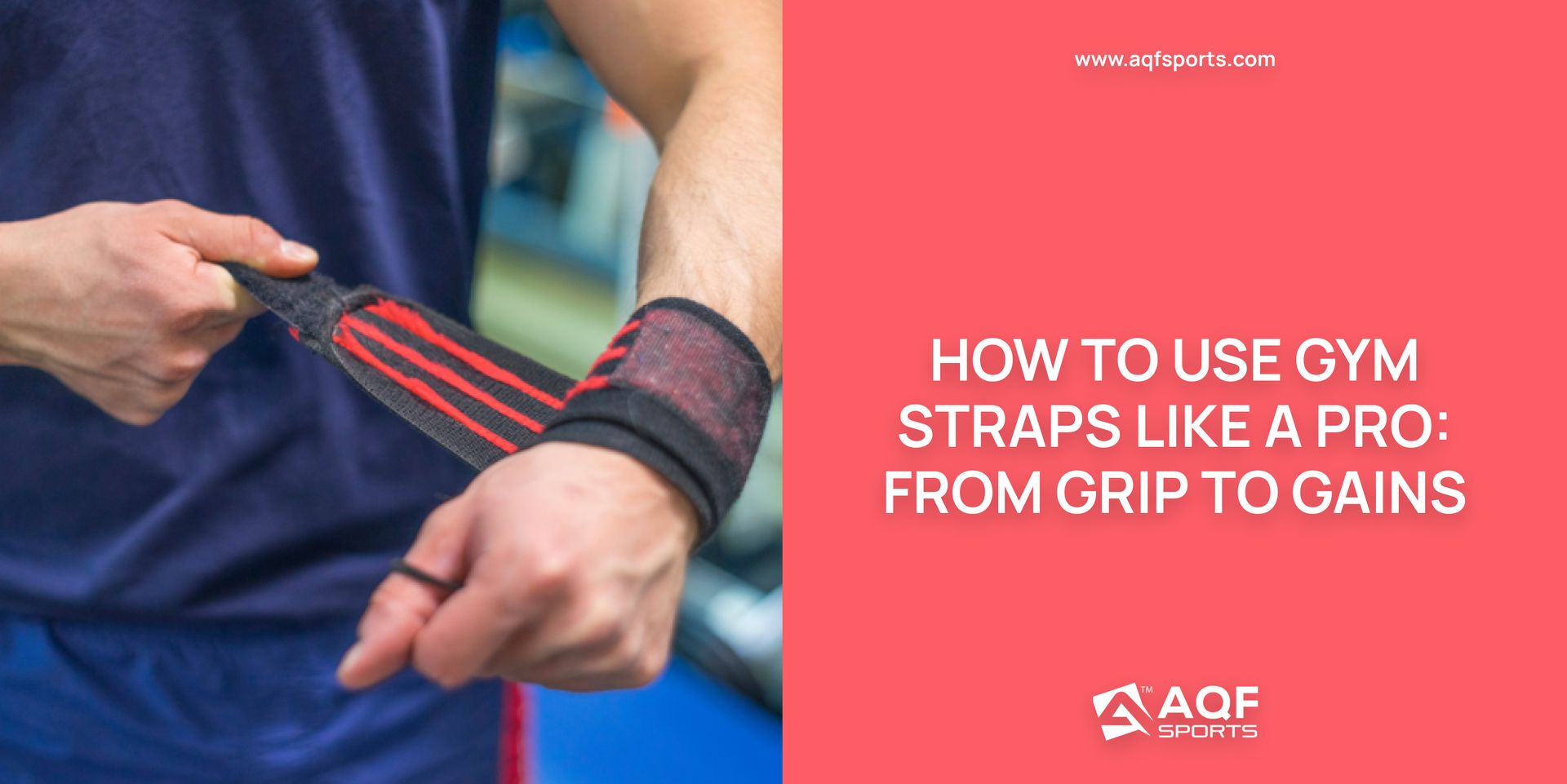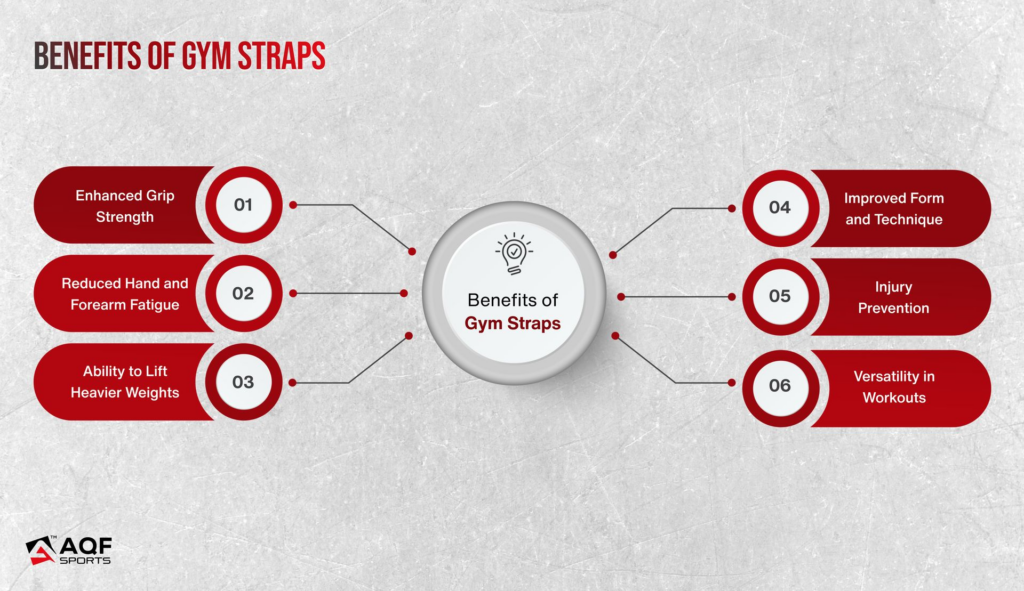How to Use Gym Straps Like A Pro: From Grip to Gains

Do you feel yourself at a point where your grip strength is holding you back from lifting heavier weights? This is a common challenge many lifters face. But gym straps can be a game changer. Proper knowledge of how to use gym straps can help you overcome this hurdle. Moreover, gym straps improve your overall form and reduce the risk of injury. In this blog, we’ll delve into the benefits of gym straps, their types, and a step-by-step guide to using them effectively.
So, gear up to take your strength training to the next level!
Key Takeaways
- Gym straps improve grip strength and distribute the load evenly across the wrists and forearms, reducing the risk of fatigue on hands and fingers.
- Position the straps around your wrists to wrap them around the bar. Adjust the grip for maximum performance and safety. Detailed guide ahead.
- Discover various types of gym straps , each designed to cater to specific needs and preferences.
Benefits of Gym Straps
Gym weighlifting straps are an essential tool for weightlifters and fitness freaks. They help you enhance your workouts and maximise your performance. Whether you are a newbie or an advanced lifter, gym straps can significantly benefit you. Let’s see how!
Enhanced Grip Strength
One of the main benefits of using gym straps is the enhancement of grip strength. Usually, your grip becomes the limiting factor during heavy lifting. The gym straps wrap around your wrists and the bar. Thus, providing you with additional support and allowing you to hold onto weights more securely. This support prevents your grip from giving out prematurely during heavy lifting. It is particularly beneficial for exercises like deadlifts, rows, and pull-ups.
Reduced Hand and Forearm Fatigue
Gym straps help to distribute the load more evenly across your wrists and forearms. Thus, reducing strains on your hands and fingers. This distribution is crucial during high rep sets or lifting heavy weights. This is because it minimises hand and forearm fatigue. This decreases the demand on smaller muscle groups. So, you can increase your focus on the larger muscle groups. Thus, leading to more effective workouts and overall better muscle development.
Ability to Lift Heavier Weights
With the added grip support, you can lift heavier weights as compared to bare hands. This ability is particularly helpful for strength training and bodybuilding, where progressively increasing the lifting weight is essential for muscle growth and strength gain. Using gym straps allows you to push past your normal limits and achieve new personal records. Thus, fostering continuous improvement in your training.
Improved Form and Technique
Maintaining proper form is essential in weightlifting to avoid injury. Proper form also ensures that the targeted muscles are being effectively worked. When your grip weakens, it compromises your form. Thus, leading to improper technique and increased risk of injury. Gym straps help maintain a secure grip on the bar. Thus, allowing you to focus on maintaining proper form and technique. This focus is particularly essential for complex movements like deadlifts.
Injury Prevention
Using gym straps can save you from injuries related to grip fatigue and improper form. A secure grip is essential during heavy weightlifting to prevent the weights from slipping. Gym straps reduce the strain on your hands and wrists. Thus, reducing the risk of injuries related to overuse. For example, tendonitis. Moreover, enabling you to maintain proper form helps prevent injuries related to poor lifting technique.
Versatility in Workouts
Gym straps can be used for a wide range of exercises. Thus, making them a versatile addition to your gym gear. Whether you are performing deadlifts, pull-ups, rows, or shrugs, gym straps enhance your overall performance. They also allow you to focus more on the intended muscle groups. This quality makes gym straps a valuable tool for those looking to diversify their workout routine and target different muscle groups effectively.

Types of Gym Straps
Gym straps, also known as lifting straps, come in various types. Each type is designed to offer specific benefits and cater to different needs. Understanding different types of gym straps can help you choose the right gear for your workouts. Following are some common types of gym straps:
Lasso Straps
These are the most common type of gym straps. They have a loop at one end through which the opposite end is threaded, so they can be tightened around the wrist.
They have long straps that can be wrapped multiple times around the bar for a secure grip. They are often made from cotton or nylon for longevity.
They are best for deadlifts, shrugs, rows, and other heavy-lifting exercises.
Figure 8 Straps
Figure 8 straps are named for their shape as they resemble the number 8. They have two loops that go around the writs and the bar. Thus, providing a secure grip.
They are usually made from thick cotton or nylon. It provides an exceptionally strong and stable grip. They prevent the bar from slipping, enhancing safety. But the two loops create a fixed length. Thus, limiting adjustability.
They are best for Strongman training, heavy pulling movements and deadlifting.
Single loop Straps
Single-loop straps consist of a single loop that goes around the wrist. The other loop is wrapped around the bar. They are typically shorter than the lasso straps.
They provide moderate support and grip enhancements. These are good for lifters who need some grip assistance but prefer minimalistic gear.
They are best for Olympic lifts, lighter lifting sessions, and exercises requiring quick set-up.
Padded Straps
Padded Straps are similar to lasso straps but include additional padding around the wrist area. This provides extra comfort. This padding reduces the risk of abrasions and pressure-related discomfort. These are good for heavy lifting sessions, deadlifts, and long-duration lifting workouts.
Hook Straps
Hook straps come with a metal or plastic hook attached to a wrist strap. This allows the lifter to hook onto the bar instead of wrapping the strap.
Hook straps are ideal for lifters with grip strength problems or hand injuries. These are used in heavy-pulling exercises and deadlifts.
Choosing The Right Gym Strap
When selecting the right gear, consider the following factors:
- Type of exercise
- Level of support you need
- Personal preference e.g. comfort and ease of use.
How to Use The Gym Strap Step-By-Step Guide
Using the gym strap correctly can significantly improve your lifting performance. This is because it enhances your grip strength and allows you to lift heavier weights safely. Here’s a detailed step-by-step guide.
Choose The Right Type
Before you begin, ensure you choose the right type, depending on your specific requirements.
Position the Strap Around Your Wrists
- Open the loop.
- Slide your hand through the loop in a way that the strap rests on the back of your hand and the loose end hangs down.
- Pull the loose end to tighten the loop around your wrist.
Wrap the Strap Around the Bar
- Hold the bar with your hand. Let the loose end hang freely.
- Use your other hand to wrap the loose end of the strap around the bar. Start by wrapping the strap underneath the bar and then over the top. Continue until you feel the strap is firmly attached to the bar.
- Ensure that the strap is tight and doesn’t slip during the lift.
Adjust Your Grip
- Once you wrap the strap, tighten your grip around the strap and the bar.
- Make sure the grip is comfortable. Adjust the tightness if necessary.
Perform the Lift
Perform the lift normally, focusing on maintaining proper form and technique.
Bottomline
Incorporating gym straps into your routine enables you to push past your limits and achieve your fitness goals. So, get ready to take your lifting game to the next level!
Grab a pair of gym straps today and experience the difference.






